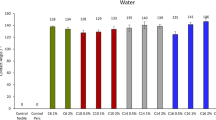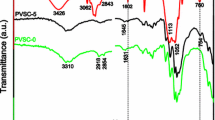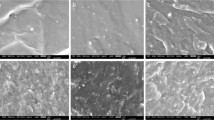Abstract
Long-chain cellulose esters (LCCEs) are recently developed cellulose derivatives showing properties that are relevant to diverse applications, such as coatings, films and plastics. The nonpolar aliphatic tails of the fatty ester groups impart strong hydrophobic properties to LCCEs, the physicochemical basis for most of the proposed uses. In previous work, we developed LCCE-based formulations as hydrophobicity-promoting agents for pure cotton textiles. Herein, we aimed to expand the use of LCCEs as eco-friendly hydrophobic additives in textiles with different compositions, namely synthetic fibers and mixtures thereof. The LCCE-based formulations were applied by a conventional textile dry-cleaning industrial process, using three types of solvents (one conventional and two green alternative ones). We observed that even for synthetic fibers or blends, there was no need to use crosslinkers to anchor LCCEs to textiles, nor need for pre-treatments to promote an increase in hydrophobic capacity. Water-repellent textiles were thus obtained through sustainable flourine-free compounds, with easy and self-cleaning properties.












Similar content being viewed by others
References
AATCC22 (2010) Water repellency - Spray test
Amicarelli V, Bux C, Spinelli MP, Lagioia G (2022) Life cycle assessment to tackle the take-make-waste paradigm in the textiles production. Waste Manag 151:10–27. https://doi.org/10.1016/j.wasman.2022.07.032
Bras J, Vaca-Garcia C, Borredon ME, Glasser W (2007) Oxygen and water vapor permeability of fully substituted long chain cellulose esters (LCCE). Cellulose 14:367–374. https://doi.org/10.1007/s10570-007-9123-2
Chen Z, Zhang J, Xiao P et al (2018) Novel thermoplastic cellulose esters containing bulky moieties and soft segments. ACS Sustain Chem Eng 6:4931–4939. https://doi.org/10.1021/acssuschemeng.7b04466
Costa C, Viana A, Silva C, Marques EF, Azoia NG (2022) Recycling of textile wastes by acid hydrolysis, into new cellulosic raw materials. Waste Manage 153:99–109. https://doi.org/10.1016/j.wasman.2022.08.019
Costa C, Silva C, Marques EF, Azoia NG (2023) Long-chain cellulose esters from recycling textile waste as highly effective superhydrophobic additive: synthesis and evaluation. Cellulose 30:2913–2928. https://doi.org/10.1007/s10570-023-05065-3
Crépy L, Chaveriat L, Banoub J et al (2009) Synthesis of cellulose fatty esters as plastics-influence of the degree of substitution and the fatty chain length on mechanical properties. ChemSusChem 2:165–170. https://doi.org/10.1002/cssc.200800171
Crépy L, Monchau F, Chai F et al (2012) Evaluation of a bio-based hydrophobic cellulose laurate film as biomaterial-study on biodegradation and cytocompatibility. J Biomed Mater Res Part B Appl Biomater 100B:1000–1008. https://doi.org/10.1002/jbm.b.32665
Di Mundo R, Palumbo F (2014) Wettability: Significance and measurement. Polymer Surface Characterization. De Gruyter, Berlin, pp 207–246
Diaa M, Hassabo AG (2022) Self-cleaning properties of cellulosic fabrics: a review. Review. 12:1847–1855
Fan Z, Li Q, Cai X et al (2017) Synthesis of core-shell fluorine-silicon containing polyacrylate latexes for water and oil repellent finishing of cotton fabric. Indian J Fibre Text Res 42:495–501
Geyer F, D’Acunzi M, Sharifi-Aghili A et al (2020) When and how self-cleaning of superhydrophobic surfaces works. Sci Adv. https://doi.org/10.1126/sciadv.aaw9727
Giesy JP, Kannan K (2001) Global distribution of perfluorooctane sulfonate in wildlife. Environ Sci Technol 35:1339–1342. https://doi.org/10.1021/es001834k
Havimo M, Jalomäki J, Granström M et al (2011) Mechanical strength and water resistance of paperboard coated with long chain cellulose esters. Packag Technol Sci 24:249–258. https://doi.org/10.1002/pts.932
Hosseini S (2020) Self-Cleaning surfaces for different purposes : Review of production methods and future prospects. In: International conference on materials enginnering and metallurgy
ISO 23232 (2009) Textiles–Aqueous liquid repellency––Water/alcohol solution resistance test
ISO 3175 (2017) Textile - professional care, drycleaning and wetcleanin of fabrics and garments - Part 2: procedure for testing performance when cleaning and finishing using tetracholoethene
ISO 3758 (2012) Textiles — Care labelling code using symbols
ISO 6330 (2012) Textiles: Domestic washing and drying procedures for textile testing
Kallio AMI (2021) Wood-based textile fibre market as part of the global forest-based bioeconomy. For Policy Econ 123:102364. https://doi.org/10.1016/j.forpol.2020.102364
Kim J, Yun C, Park Y, Park CH (2015) Post-consumer energy consumption of textile products during ‘use’ phase of the lifecycle. Fibers Polym 16:926–933. https://doi.org/10.1007/S12221-015-0926-8
Klinkhammer K, Rohleder E, Graßmann C, Janssen E (2017) Structured textile surfaces for easy-to-clean properties towards dry soil. Mater Today Proc 4:S101–S106. https://doi.org/10.1016/j.matpr.2017.09.174
Munasinghe P, Druckman A, Dissanayake DGK (2021) A systematic review of the life cycle inventory of clothing. J Clean Prod 320:128852. https://doi.org/10.1016/j.jclepro.2021.128852
Muthu SS (2020) Calculating the water and energy footprints of textile products. Assess Environ Impact Text Cloth Supply Chain. https://doi.org/10.1016/B978-0-12-819783-7.00004-1
Sethi SK, Manik G (2018) Recent progress in super hydrophobic/hydrophilic self-cleaning surfaces for various industrial applications: a review. Polym Plast Technol Eng 57:1932–1952. https://doi.org/10.1080/03602559.2018.1447128
Uschanov P, Johansson L-S, Maunu SL, Laine J (2011) Heterogeneous modification of various celluloses with fatty acids. Cellulose 18:393–404. https://doi.org/10.1007/s10570-010-9478-7
Volvo Test 85000010 (2016) Resistance to staining, resistance to soiling and cleanability textile upholstery
Wei DW, Wei H, Gauthier AC et al (2020) Superhydrophobic modification of cellulose and cotton textiles: methodologies and applications. J. Bioresour. Bioprod. 5(1):15
Willberg-Keyriläinen P, Ropponen J (2019) Evaluation of esterification routes for long chain cellulose esters. Heliyon 5:e02898. https://doi.org/10.1016/j.heliyon.2019.e02898
Willberg-Keyriläinen P, Vartiainen J, Harlin A, Ropponen J (2017) The effect of side-chain length of cellulose fatty acid esters on their thermal, barrier and mechanical properties. Cellulose 24:505–517. https://doi.org/10.1007/s10570-016-1165-x
Willberg-Keyriläinen P, Ropponen J, Alakomi H-L, Vartiainen J (2018) Cellulose fatty acid ester coated papers for stand-up pouch applications. J Appl Polym Sci 135:46936. https://doi.org/10.1002/app.46936
Willberg-Keyriläinen P, Rokkonen T, Malm T et al (2020) Melt spinnability of long chain cellulose esters. J Appl Polym Sci 137:49588. https://doi.org/10.1002/app.49588
Yan L, Chouw N, Jayaraman K (2014) Flax fibre and its composites–a review. Compos Part B Eng 56:296–317. https://doi.org/10.1016/j.compositesb.2013.08.014
Yun C, Islam MI, LeHew M, Kim J (2016) Assessment of environmental and economic impacts made by the reduced laundering of self-cleaning fabrics. Fibers Polym 17:1296–1304. https://doi.org/10.1007/s12221-016-6320-3
Funding
This work was supported by a PhD grant (ref SFRH/BD/138665/2018) financed by national funds through Fundação para a Ciência e a Tecnologia I.P and by the North Portugal Regional Operational Programme under Portugal 2020 through the European Social Fund (ESF). Financial support from CIQUP (UIDB/00081/2020) and IMS (LA/P/0056/2020) are also gratefully acknowledged.
Author information
Authors and Affiliations
Contributions
CC: investigation, formal analysis, validation, writing–original draft, writing—review & editing; CS: supervision, writing—review & editing; EFM: supervision, resources, funding acquisition, writing–review & editing; NGA: conceptualization, supervision, writing–original draft, writing–review & editing.
Corresponding authors
Ethics declarations
Competing interests
The authors have no competing interests as defined by Springer, or other interests that might be perceived to influence the results and/or discussion reported in this paper.
Consent for publication
All of the material is owned by the authors and/or no permissions are required.
Additional information
Publisher's Note
Springer Nature remains neutral with regard to jurisdictional claims in published maps and institutional affiliations.
Supplementary Information
Below is the link to the electronic supplementary material.
Rights and permissions
Springer Nature or its licensor (e.g. a society or other partner) holds exclusive rights to this article under a publishing agreement with the author(s) or other rightsholder(s); author self-archiving of the accepted manuscript version of this article is solely governed by the terms of such publishing agreement and applicable law.
About this article
Cite this article
Costa, C., Silva, C., Marques, E.F. et al. A sustainable approach for providing water repellency in textiles by using long-chain cellulose esters. Cellulose 30, 7347–7362 (2023). https://doi.org/10.1007/s10570-023-05311-8
Received:
Accepted:
Published:
Issue Date:
DOI: https://doi.org/10.1007/s10570-023-05311-8




